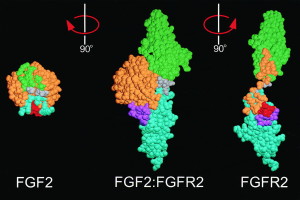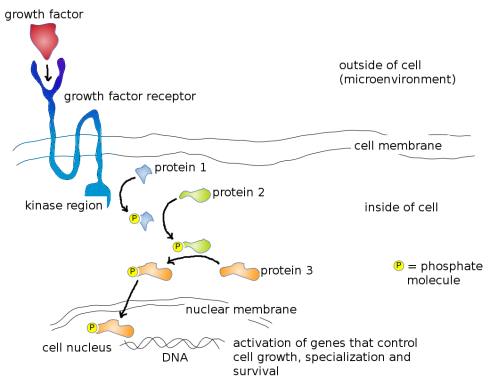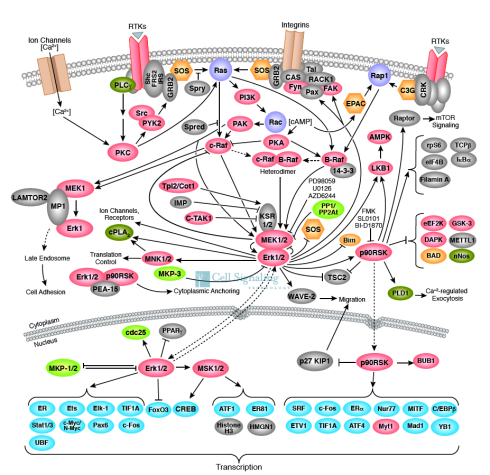The Hallmarks of Cancer: Growth Factors and Cell Signaling

This article originally appeared on Know The Cosmos. I will be re-posting excerpts here for Australian Science with added commentary over the coming weeks!
“The Hallmarks of Cancer” are ten anti-cancer defense mechanisms that are hardwired into our cells, that must be breached by a cell on the path towards cancer. The First Hallmark of Cancer is defined as “Self-Sufficiency in Growth Signals”. What does this mean? In this post I will give an overview of growth factors and how they arhow growth signals are intimately involved in the development of cancer, it is necessary to define and understand what growth factors are, and explain how they control normal cellular behavior.
Growth Factors

Growth factors are, simply put, substances that control the multiplication of cells. There are many different types of growth factors, but they all have several characteristics in common. They are all proteins, and present at very low concentrations in tissues but with a high biological activity. They are responsible for controlling essential functions within the cell; growth, specialization and survival. Growth factors also do not circulate in the blood stream; instead, they act locally in areas near the cells that produce them. The image on the right shows a growth factor known as Vascular Endothelial Growth Factor (VEGF).
Cell Signaling

It is impossible to talk about growth factors and cancer without going over some of the basics of cell signaling. We are multi-cellular animals, and as such, our cells need to communicate with each other, so they can act in a coordinated manner in response to the environment. The basis of this communication comes from a process known as cell signaling.
The behavior of a cell depends on its immediate surrounding environment, known as the microenvironment. The assortment of growth factors in this microenvironment is the most important aspect regulating the behavior of that cell. All growth factors exert their effects by binding to a receptor. Receptors are proteins found on the surface of a cell that receive such chemical signals from the outside of the cell. Each growth factor has it’s own receptor; think of it as a key (the growth factor) fitting into a lock (the receptor). Growth factor receptors tend to be ‘transmembrane molecules’; this means that one end of the receptor ‘sticks out’ through the cell membrane into the microenvironment while the other end projects inside the cell. By spanning across the cell membrane, growth factor receptors are able to communicate signals from outside the cell (e.g. presence of growth factors in the microenvironment) to the inside of the cell. Revisiting the lock and key analogy, think of it as a key that fits into a lock that protrudes through the door-frame, instead of being flush against the door.
The binding of the growth factor to its specific receptor triggers a phosphorylation reaction inside the cell. Phosphorylation, or the addition of a phosphate group to a protein molecule, is an important step in cell signaling. This is because many proteins exist in an ‘on’ or ‘off’ state that can be switched by phosphorylation. Therefore, phosphorylation is a key step in regulating their activity. The enzymes that add phosphate groups to proteins are known as kinases; enzymes that remove phosphates are known as phosphatases. The exterior end of the receptor protein (the bit that sticks out of the cell) carries the growth factor binding site; the other end which projects inside the cell carries a kinase site. Binding of growth factor to the receptor binding site activates the kinase domain on the interior end of the receptor protein. This activated kinase, true to it’s name, then goes on to add phosphate groups to other proteins inside the cell, which then activate more proteins downstream, triggering a signaling cascade that finally ends with the activation of genes that bring about….you guessed it, cellular growth, specialization, or survival! The image below illustrates this process – I couldn’t find a decent one online so I made my own!

The description above is an extremely simplified version of what happens inside a cell; in reality, it is not so much a linear signaling pathway as it is an interwoven, intricate signaling web, with promiscuous proteins from many different pathways activating and repressing one another. The image below is not meant to frighten you (!) but rather to give you an idea how truly complex just one such signaling pathway, known as the MAPK/Erk pathway is.

So there you have it. We’ve covered the basics of cell signaling and the molecular mechanisms that cause a cell to grow. Next time…I will explain what goes wrong with these processes in a cancer cell.
Samarasinghe B (2013-09-09 07:38:42). The Hallmarks of Cancer: Growth Factors and Cell Signaling. Australian Science. Retrieved: Dec 06, 2025, from https://ozscience.com/biology/the-hallmarks-of-cancer-growth-factors-and-cell-signaling/
 Follow
Follow
1 thought on “The Hallmarks of Cancer: Growth Factors and Cell Signaling”
Comments are closed.